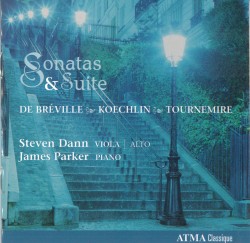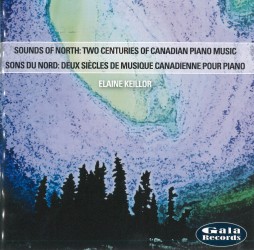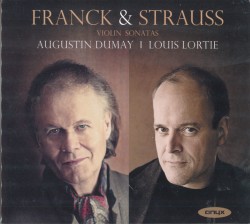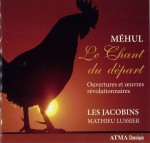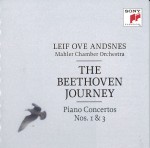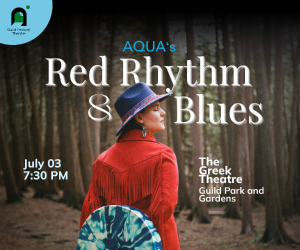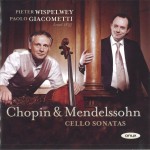 The dutch cellist Pieter Wispelwey has lived with the Bach Cello Suites for virtually his entire professional career, having explored them and played them in recital close to an astonishing 1,000 times. He has already recorded them twice, 14 and 21 years ago, but decided to celebrate his 50th birthday last September by recording them for a third time; the new 2-CD plus DVD set on Evil Penguin Records Classic (EPRC 012) is the result. Given Wispelwey’s ongoing relationship with the pieces, however, he readily admits that this won’t be the end of the road. “Six suites, six recordings,” he says in the DVD; “Why not?” Wispelwey also took this opportunity to “take the plunge,” in his own words, and do something he had done in private but had never dared to do in concert: tune his cellos down from the standard 415 baroque pitch to 392, the contemporary pitch in Cöthen, where Bach wrote the suites around 1720. This dropped the tuning a semi-tone; it gave him, he says, “the sensation of entering rooms that I hadn’t been in before or didn’t know existed.”
The dutch cellist Pieter Wispelwey has lived with the Bach Cello Suites for virtually his entire professional career, having explored them and played them in recital close to an astonishing 1,000 times. He has already recorded them twice, 14 and 21 years ago, but decided to celebrate his 50th birthday last September by recording them for a third time; the new 2-CD plus DVD set on Evil Penguin Records Classic (EPRC 012) is the result. Given Wispelwey’s ongoing relationship with the pieces, however, he readily admits that this won’t be the end of the road. “Six suites, six recordings,” he says in the DVD; “Why not?” Wispelwey also took this opportunity to “take the plunge,” in his own words, and do something he had done in private but had never dared to do in concert: tune his cellos down from the standard 415 baroque pitch to 392, the contemporary pitch in Cöthen, where Bach wrote the suites around 1720. This dropped the tuning a semi-tone; it gave him, he says, “the sensation of entering rooms that I hadn’t been in before or didn’t know existed.”
Wispelwey plays a 1710 Pieter Rombouts baroque cello for the first five suites, and an anonymous 18th-century five-string violoncello piccolo for the sixth. His familiarity with this music is obvious from the free-flowing opening bars of the Suite No.1 in G Major; there’s a great sense of flow and structure here, and a confidence and assurance in the playing that doesn’t preclude a sense of joyful exploration; it’s as if we are fortunate enough to be joining Wispelwey on yet another of his journeys through these wonderful works, and are witness to his new discoveries.
The DVD, entitled 392, Pieter Wispelwey and the Bach Cello Suites, is an entertaining 52-minute documentary filmed during Wispelwey’s dress rehearsal for the recording, a concert performance of all six suites at the Holywell Concert Room in Oxford in May of last year; excerpts from the recital are interspersed with discussions and observations about Bach and contemporary performance issues — particularly for the dance movements — with Bach scholars Laurence Dreyfus of Oxford University and Glasgow University’s John Butt. Fascinating booklet notes and an attractive presentation box format help to make this a set to treasure.
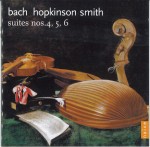
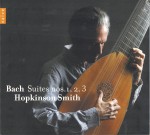 The Six Cello Suites also turn up in transcriptions on two naïve CDs from American lutenist Hopkinson Smith, Bach Suites Nos.1, 2, 3 (E 8937) being performed on theorbo, and Bach Suites Nos.4, 5, 6 (E 8938) on lute. Despite the consecutive numbers, the two CDs are not issued as a set; the first is in an attractive cardboard Digipak, while the second is in a traditional plastic jewel case. There’s a quite different feel to the suites in these performances — they’re softer and gentler, for a start, with Suites 1 to 3 transposed up a fourth and Suite 4 up a fifth — but the music doesn’t seem to suffer; indeed, the opportunity for fuller accompaniment and added bass lines serves to clarify and expand the harmonies implicit in the solo cello writing. And again, there’s that sense of journeying and exploring, of participating with an interpreter in an intimate personal experience that underlines yet again just how much depth these works have. Detailed booklet notes explain the choice of instruments, tunings and transpositions.
The Six Cello Suites also turn up in transcriptions on two naïve CDs from American lutenist Hopkinson Smith, Bach Suites Nos.1, 2, 3 (E 8937) being performed on theorbo, and Bach Suites Nos.4, 5, 6 (E 8938) on lute. Despite the consecutive numbers, the two CDs are not issued as a set; the first is in an attractive cardboard Digipak, while the second is in a traditional plastic jewel case. There’s a quite different feel to the suites in these performances — they’re softer and gentler, for a start, with Suites 1 to 3 transposed up a fourth and Suite 4 up a fifth — but the music doesn’t seem to suffer; indeed, the opportunity for fuller accompaniment and added bass lines serves to clarify and expand the harmonies implicit in the solo cello writing. And again, there’s that sense of journeying and exploring, of participating with an interpreter in an intimate personal experience that underlines yet again just how much depth these works have. Detailed booklet notes explain the choice of instruments, tunings and transpositions.
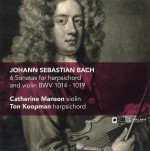 It would be hard to imagine a more suitable pair of performers for the Bach 6 Sonatas for Harpsichord and Violin BWV 1014–1019 than Catherine Manson and Ton Koopman, or a better performance than they give on a new Challenge Classics 2-CD set (CC72560). The Dutch Baroque specialist Koopman, now nearly 70, founded the Amsterdam Baroque Orchestra in 1979; Manson became its leader in 2006.
It would be hard to imagine a more suitable pair of performers for the Bach 6 Sonatas for Harpsichord and Violin BWV 1014–1019 than Catherine Manson and Ton Koopman, or a better performance than they give on a new Challenge Classics 2-CD set (CC72560). The Dutch Baroque specialist Koopman, now nearly 70, founded the Amsterdam Baroque Orchestra in 1979; Manson became its leader in 2006.
As the excellent and detailed booklet notes by Christoph Wolff point out, this set of innovative sonatas forms a pivotal link between the baroque trio sonata and the classical duo sonata of the late 18th century. There is true partnership in the writing, as there is in these outstanding performances. Koopman’s harpsichord sound is strong, deep and warm; Manson’s violin sound is the perfect companion and counterpart: light, but never lacking in depth.
Beautifully recorded, this is intelligent playing full of sensitivity, energy and drive.
Paul Hindemith was a world-class viola player, so it’s not surprising that there is a significant amount of music for viola in his chamber output, nor is it surprising that it brilliantly exploits the instrument’s full range and character.
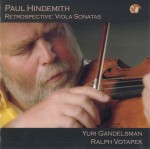 Two of his three sonatas for viola and piano and the second of his four sonatas for solo viola are presented on Paul Hindemith Retrospective: Viola Sonatas, in outstanding performances by Yuri Gandelsman and pianist Ralph Votapek (Blue Griffin BGR277). The duo works are theSonata Op.11 No.4 from 1919, the year that Hindemith decided to change to viola from violin, which until then had been his primary instrument, and the final sonata of the three, dating from 1939. The solo sonata is the Op.25 No.1 from 1922. A short Capriccio, arranged by Gandelsman from Hindemith’s Op.8 No.1 work of the same title for cello and piano, concludes a marvellous CD.
Two of his three sonatas for viola and piano and the second of his four sonatas for solo viola are presented on Paul Hindemith Retrospective: Viola Sonatas, in outstanding performances by Yuri Gandelsman and pianist Ralph Votapek (Blue Griffin BGR277). The duo works are theSonata Op.11 No.4 from 1919, the year that Hindemith decided to change to viola from violin, which until then had been his primary instrument, and the final sonata of the three, dating from 1939. The solo sonata is the Op.25 No.1 from 1922. A short Capriccio, arranged by Gandelsman from Hindemith’s Op.8 No.1 work of the same title for cello and piano, concludes a marvellous CD.
Gandelsman’s tone is full and rich across the complete range of the instrument – hardly surprising, given that he plays a 1748 Paolo Testore viola – and what a range it is in Hindemith’s hands! Add faultless technique and a lovely range of dynamics from both players and you have a real winner. The CD was recorded thanks to a grant from Michigan State University, where Gandelsman is professor of viola at the College of Music. The sound quality is absolutely top notch.
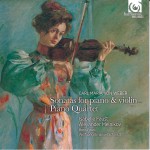 The ever-reliable harmonia mundi label has added another winner to its catalogue with the Sonatas for Piano & Violin and the Piano Quartet ofCarl Maria von Weber (HMC 902108). Violinist Isabelle Faust andAlexander Melnikov, playing an original ca.1815 fortepiano, are in great form in the sonatas and are joined by violist Boris Faust and cellist Wolfgang Emanuel Schmidt for the piano quartet.
The ever-reliable harmonia mundi label has added another winner to its catalogue with the Sonatas for Piano & Violin and the Piano Quartet ofCarl Maria von Weber (HMC 902108). Violinist Isabelle Faust andAlexander Melnikov, playing an original ca.1815 fortepiano, are in great form in the sonatas and are joined by violist Boris Faust and cellist Wolfgang Emanuel Schmidt for the piano quartet.
Weber (1786-1826) is mostly known for his early German Romantic operas and a few clarinet pieces, but he composed over 300 works during his short life. The Six Violin Sonatas Op.10 were written in 1810 on a commission from the publisher André, who had asked for pieces of only moderate difficulty suitable for performance in a domestic setting. Restricted by this limitation, Weber experienced a great deal of trouble with the composition and was clearly annoyed when André rejected the sonatas for being too good. The works were eventually published by Simrock under the title Progressive sonatas for fortepiano with obbligato violin, composed for and dedicated to amateur musicians. They certainly get off to a dazzling start, and it’s clear from the brilliant opening of this CD that these sonatas are quite something, even if there’s not necessarily a great emotional depth to them. And don’t be fooled by the statement in the booklet notes that “the technical demands on the performers, especially the violin, (my italics) are fairly modest…,” although they do acknowledge that the real musical difficulty lies in having to interpret the constantly changing array of styles; the sonatas aren’t in the virtuoso league by any means, but the keyboard part in particular is clearly challenging. I’d be surprised if many amateur players could handle these charming pieces at all, let alone as brilliantly as Faust and Melnikov.
The Piano Quartet Op.8 is from the previous year, although the Adagio was apparently written in 1806. The work fully deserves the description “unjustly neglected,” even if there are clearly echoes of Beethoven throughout.
The Argentinean cellist Sol Gabetta has two new CD releases, both of them of very high quality.
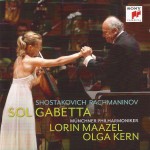 On Shostakovich Rachmaninov (Sony 88725435752) she is supported by the Münchener Philharmoniker under Lorin Maazel in a live concert performance of Shostakovich’s Cello Concerto No.1 – well, live in so far as its having been recorded over three concert dates in Munich in September 2011. There’s a complete absence of any audience sound or ambience, but the recording certainly has the electricity of a live performance. The Rachmaninov work is a regular studio recording of his Cello Sonata in G Minor Op.19, in which Olga Kern is the pianist; again, it’s a first-class performance in all respects.
On Shostakovich Rachmaninov (Sony 88725435752) she is supported by the Münchener Philharmoniker under Lorin Maazel in a live concert performance of Shostakovich’s Cello Concerto No.1 – well, live in so far as its having been recorded over three concert dates in Munich in September 2011. There’s a complete absence of any audience sound or ambience, but the recording certainly has the electricity of a live performance. The Rachmaninov work is a regular studio recording of his Cello Sonata in G Minor Op.19, in which Olga Kern is the pianist; again, it’s a first-class performance in all respects.
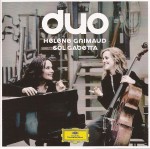 On Duo, Gabetta makes a guest appearance on the Deutsche Grammophon label for a recital with pianist Hélène Grimaud (479 0090).The two met at the Menuhin Festival in Gstaad in 2011 and formed an immediate bond; the program on this CD, the first specific duo recording for either artist, is apparently the recital program they performed in Gstaad.
On Duo, Gabetta makes a guest appearance on the Deutsche Grammophon label for a recital with pianist Hélène Grimaud (479 0090).The two met at the Menuhin Festival in Gstaad in 2011 and formed an immediate bond; the program on this CD, the first specific duo recording for either artist, is apparently the recital program they performed in Gstaad.
Schumann’s Drei Fantasiestücke Op.73 opens the disc, followed by three cello sonatas: Brahms’ No.1, Op.38; the Debussy; and the ShostakovichOp.40. The jewel case blurb quotes a review of the original concert, noting “Magical intensity and intimacy,” and it’s an extremely accurate description of the CD recital as well. From the interview conversation in the booklet notes it’s quite clear that these two performers share a very special musical relationship; the mutual understanding and the sharing of nuances is evident throughout an outstanding CD.
The exceptional violinist Tianwa Yang has been featured in this column several times over the past few years in reviews of her two separate Naxosseries of the complete works of Pablo Sarasate for violin and piano and violin and orchestra; both series are due for completion this year. Yang is the soloist on two recent unrelated Naxos releases.
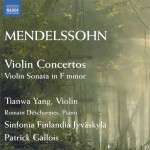 The most recent is her recording of the Mendelssohn Violin Concertos, coupled with the Violin Sonata in F minor (8.572662); Patrick Gallois leads the Sinfonia Finlandia Jyväskylä, and Romain Descharmesis the pianist in the sonata. There are so many recordings of the Mendelssohn E minor concerto that it seems as if there can’t possibly be anything new to say with it, and yet it remains almost a rite of passage for all soloists. It’s not too difficult to come up with reasons: this is, after all, the most perfect of violin concertos, and a true test of technique, tone, sensitivity, artistry and musicianship. Yang certainly displays ample technique and musical intelligence in this work, as she does throughout the CD, although her tone can tend to be somewhat nasal in the middle and lower registers. The D minor concerto is a work from Mendelssohn’s youth, written in 1822 when he was only 13; Yehudi Menuhin obtained a manuscript copy in 1951, and was essentially responsible for its revival and publication. Scored for violin and string orchestra, it contains flashes of the mature Mendelssohn, but is generally closer in style to the works of Mendelssohn’s older contemporaries Kreutzer and Rode.
The most recent is her recording of the Mendelssohn Violin Concertos, coupled with the Violin Sonata in F minor (8.572662); Patrick Gallois leads the Sinfonia Finlandia Jyväskylä, and Romain Descharmesis the pianist in the sonata. There are so many recordings of the Mendelssohn E minor concerto that it seems as if there can’t possibly be anything new to say with it, and yet it remains almost a rite of passage for all soloists. It’s not too difficult to come up with reasons: this is, after all, the most perfect of violin concertos, and a true test of technique, tone, sensitivity, artistry and musicianship. Yang certainly displays ample technique and musical intelligence in this work, as she does throughout the CD, although her tone can tend to be somewhat nasal in the middle and lower registers. The D minor concerto is a work from Mendelssohn’s youth, written in 1822 when he was only 13; Yehudi Menuhin obtained a manuscript copy in 1951, and was essentially responsible for its revival and publication. Scored for violin and string orchestra, it contains flashes of the mature Mendelssohn, but is generally closer in style to the works of Mendelssohn’s older contemporaries Kreutzer and Rode.
The violin sonata is another early work, from 1823, but the music, from the violin’s plaintive unaccompanied solo beginning, through an affecting slow movement to a quite Beethovenian Allegro Agitato finale, belies the composer’s age.
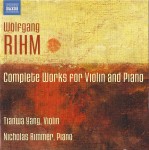 Yang’s other recent Naxos release is the Complete Works for Violin and Piano by the contemporary German composer Wolfgang Rihm, with pianist Nicholas Rimmer (8.572730).
Yang’s other recent Naxos release is the Complete Works for Violin and Piano by the contemporary German composer Wolfgang Rihm, with pianist Nicholas Rimmer (8.572730).
Despite his prolific output, I don’t recall ever hearing any of Rihm’s music. I’m sure the fault is all mine, but it may also possibly be because his music doesn’t seem to lend itself to standard radio or recital programming; it’s not always an easy listening experience, not strong on melody and with a good deal of stop/start passages in some of the pieces, and with some odd effects at the extremes of the violin’s physical range and also in the piano writing. Rihm is very highly regarded though, particularly in Europe, and although the jewel case is typically over-effusive in describing Rihm’s style as “…almost unique in today’s music in marrying contemporary technique with emotionally powerful resonances” this is obviously a very strong voice with a distinct character. Yang and Rimmer are clearly very much at home in these pieces, and give strong, assured performances throughout the CD. The five works span Rihm’s career, from Hekton (1972) and Eine Violinsonate (1971/75) through two pieces from the early 1990s, Antlitz and Phantom und Eskapade, to the world premiere recording of Über die Linie VII for solo violin, from 2006. I found the latter to be the most accessible and effective work of the five, although Phantom und Eskapade has some beautiful moments.
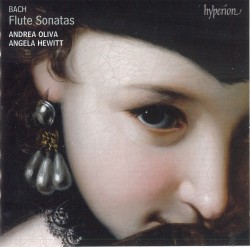 Bach – Flute Sonatas
Bach – Flute Sonatas

